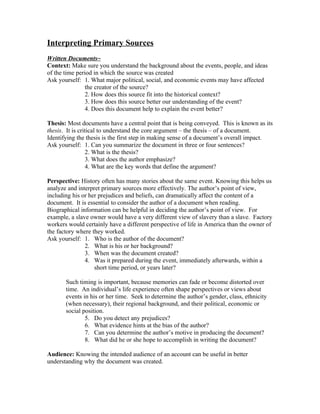
Interpreting Primary Sources Effectively
- 1. Interpreting Primary Sources Written Documents~ Context: Make sure you understand the background about the events, people, and ideas of the time period in which the source was created Ask yourself: 1. What major political, social, and economic events may have affected the creator of the source? 2. How does this source fit into the historical context? 3. How does this source better our understanding of the event? 4. Does this document help to explain the event better? Thesis: Most documents have a central point that is being conveyed. This is known as its thesis. It is critical to understand the core argument – the thesis – of a document. Identifying the thesis is the first step in making sense of a document’s overall impact. Ask yourself: 1. Can you summarize the document in three or four sentences? 2. What is the thesis? 3. What does the author emphasize? 4. What are the key words that define the argument? Perspective: History often has many stories about the same event. Knowing this helps us analyze and interpret primary sources more effectively. The author’s point of view, including his or her prejudices and beliefs, can dramatically affect the content of a document. It is essential to consider the author of a document when reading. Biographical information can be helpful in deciding the author’s point of view. For example, a slave owner would have a very different view of slavery than a slave. Factory workers would certainly have a different perspective of life in America than the owner of the factory where they worked. Ask yourself: 1. Who is the author of the document? 2. What is his or her background? 3. When was the document created? 4. Was it prepared during the event, immediately afterwards, within a short time period, or years later? Such timing is important, because memories can fade or become distorted over time. An individual’s life experience often shape perspectives or views about events in his or her time. Seek to determine the author’s gender, class, ethnicity (when necessary), their regional background, and their political, economic or social position. 5. Do you detect any prejudices? 6. What evidence hints at the bias of the author? 7. Can you determine the author’s motive in producing the document? 8. What did he or she hope to accomplish in writing the document? Audience: Knowing the intended audience of an account can be useful in better understanding why the document was created.
- 2. Ask yourself: 1. Was the document created for a specific audience – women, members of Congress, African Americans, wealthy businessmen, immigrants, a friend, for example? 2. Was the document prepared for public distribution? 3. Was it a speech, a newspaper, or a magazine article or editorial, an official government report, a published memoir or autobiography, to name a few? 4. Was it produced for personal and private reflection, such as a diary or letters between friends? Public consumption documents tend to be carefully worded, often guarded in presentation, while private ones tend to be less cautious and more honest. Classifying or identifying the document can be helpful in understanding its contents. Significance: Finally, and perhaps most important, you should determine why a document is important. Ask yourself: 1. Why is the document important? 2. How has it shaped our understanding of the event? 3. How has it shaped our understanding of historical change or continuity over time? 4. What does it tell us about the historical time period? Visual Images~ Many of these same techniques are used when interpreting a painting, cartoon or photograph. In addition to the above questions (the ones that make sense when looking at a visual image), consider these questions as well… 1.What is your overall impression? What thoughts or emotions does it conjure? 2. What activities are depicted in the image? How and why are those activities significant? 3. Does the artist make use of symbols? If so, what are they? What is their significance? 4. Who or what is portrayed positively? Negatively? What can you infer from this?
- 3. TYPE OF SOURCE (Check one): 1. ___ Newspaper ___ Map ___ Advertisement ___ Letter ___ Telegram ___ Congressional record ___ Cartoon ___ Press release ___ Painting/Drawing ___ Memorandum ___ Report ___ Photograph 2. IF IT’S NOT A RECREATION:UNIQUE PHYSICAL QUALITIES OF THE DOCUMENT (Check one or more): ___ Interesting letterhead ___ Notations ___ Handwritten ___ "RECEIVED" stamp ___ Typed ___ Other ___ Seals 3. DATE(S) OF DOCUMENT AND DATES OF THE EVENT IT IS DISCUSSING: ___________________________________________________________________________ 4. AUTHOR (OR CREATOR) OF THE DOCUMENT: ___________________________________________________________________________ POSITION (TITLE): ___________________________________________________________________________ 5. FOR WHAT AUDIENCE WAS THE DOCUMENT CREATED? ___________________________________________________________________________ 6. DOCUMENT INFORMATION (There are many possible ways to answer A-E.) A. List three things about this source that you think are important: ___________________________________________________________________________ ___________________________________________________________________________ ___________________________________________________________________________ B. Why do you think this document was created? If it is written, what is its thesis? ___________________________________________________________________________ ___________________________________________________________________________ C. What evidence in the document helps you know why it was created? Explain. ___________________________________________________________________________ ___________________________________________________________________________ D. List two things the document tells you about life in the United States at the time it was created: ___________________________________________________________________________ ___________________________________________________________________________ E. Write a question to the creator that is left unanswered by the document: ___________________________________________________________________________ ___________________________________________________________________________ F. What evidence do you see of the creator’s bias, if any? Explain using the document. ___________________________________________________________________________ ___________________________________________________________________________ G. Anything else? ___________________________________________________________________________ ___________________________________________________________________________